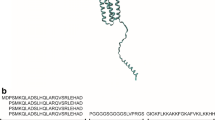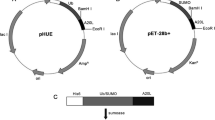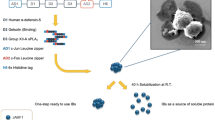Abstract
The human beta defensins-4 (hBD4) exhibit a broad range of antimicrobial properties and are thought to be ideal therapeutic agents because of their potential ability to circumvent the problems of acquired resistance often observed with other antimicrobial therapies. We report here the application of small ubiquitin-related modifier (SUMO) fusion technology to the expression and purification of cationic antibacterial peptide hBD4. The fusion protein expressed in a soluble form was purified to a purity of 90% by Ni-IDA chromatography and 637 mg protein of interest was obtained per liter of fermentation culture. After the SUMO-hBD4 fusion protein was cleaved by the SUMO protease at 30 °C for 1 h, the cleaved sample was re-applied to a Ni-IDA. Finally, about 166 mg recombinant hBD4 was obtained from 1 L fermentation culture with no less than 96% purity and the recombinant hBD4 had similar antimicrobial properties to the synthetic hBD4. Thus, the SUMO-mediated peptide expression and purification system potentially could be employed for the production of recombinant cytotoxic peptides.





Similar content being viewed by others
Abbreviations
- hBD4:
-
The human beta defensins-4
- SUMO:
-
Small ubiquitin-related modifier
- IPTG:
-
Isopropyl-β-D-1-thiogalactopyranoside
- MIC:
-
The minimal inhibitory concentration
References
Andres P (2002) Trends Microbiol 10:179–186
Butt TR, Edavettal SC, Hall JP, Mattern MR (2005) Protein Expres Purif 43:1–9
Chen HQ, Fan LM, Xu ZN, Yin XF, Cen PL (2007) Process Biochem 42:423–428
Ganz T (2004) CR Biol 327:539–549
Garcia JR, Krause A, Schulz S, Rodriguez-Jimenez FJ, Kluver E, Adermann K, Forssmann U, Frimpong-Boateng A, Bals R, Forssmann WG (2001) Faseb J 15:1819–1821
Keymanesh K, Soltani S, Sardari S (2009) World J Microb Biot 25:933–944
Koczulla AR, Bals R (2003) Drugs 63:389–406
Lehrer RI, Rosenman M, Harwig SL, Jackson R, Eisenhauer P (1991) J Immunol Methods 137:167–173
Ma XY, Zheng WY, Wei DZ, Ma YS, Wang TW, Wang JZ, Liu Q, Yang S (2006) J Biotechnol 123:367–378
Pyo SH, Lee JH, Park HB, Cho JS, Kim HR, Han BH, Park YS (2004) Process Biochem 39:1731–1736
Rao XC, Li S, Hu JC, Jin XL, Hu XM, Huang JJ, Chen ZJ, Zhu JM, Hu FQ (2004) Protein Expres Purif 36:11–18
Robert WK, Selitrennikoff CP (1986) Biochim Biophys. Acta 880:161–170
Skosyrev VS, Rudenko NV, Yakhnin AV, Zagranichny VE, Popova LI, Zakharov MV, Gorokhovatsky AY, Vinokurov LM (2003) Protein Expres Purif 27:55–62
Sun Z, Xia Z, Bi F, Liu JN (2008) Appl Microbiol Biot 78:495–502
Wu XP, Nie CJ, Huang ZF, Nie YF, Yan QX, Xiao YC, Su ZJ, Huang YD, Xiao J, Zeng YY, Tan Y, Feng WK, Li XK (2009) Mol Biotechnol 42:68–74
Xu Z, Zhong Z, Huang L, Peng L, Wang F, Cen P (2006) Appl Microbiol Biot 72:471–479
Acknowledgments
This work was financially supported by National Nature Science Foundation of China, (No. 30270193) and Natural Science Foundation of Jiangsu Province, China (No. BK2006221).
Author information
Authors and Affiliations
Corresponding author
Rights and permissions
About this article
Cite this article
Li, J.F., Zhang, J., Zhang, Z. et al. Production of Bioactive Human Beta-Defensin-4 in Escherichia coli Using SUMO Fusion Partner. Protein J 29, 314–319 (2010). https://doi.org/10.1007/s10930-010-9254-4
Published:
Issue Date:
DOI: https://doi.org/10.1007/s10930-010-9254-4




